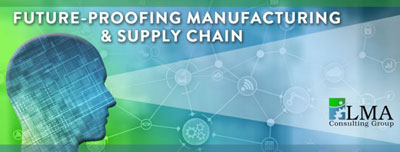Disruptions abound in supply chain circles. Just consider any of the following recent events: the tariff war, global unrest, the Coronavirus, natural disasters such as the volcano in the Philippines, the Hong Kong protests and more. We have never had a client that could claim that 100% of the extended supply chain (from suppliers’ suppliers to customers’ customers) was inside the U.S. Thus, we have to be prepared to navigate these types of disruptions and the related impacts.
Disruptions certainly go beyond your physical supply chain. What about your human capital, technologies (accompanied with processes) and strategies? Refer to our article on future-proofing your skills gap and assess which risks might be on the horizon in your industry. When it comes to technologies, there is no doubt that emerging technologies are gaining steam and are starting to transform supply chains. Just consider the application of collaborative robots, automation, RPA (robotic process automation), artificial intelligence, IoT, blockchain, and predictive analytics to name a few. Big name companies are dropping big dollars into these technologies. When thinking about strategy, remember strategy is no longer a multi-year exercise. We must be thinking in terms of strategic sprints. Who knows what will happen beyond a year out!
Several high-level categories should be assessed as you think about your supply chain:
- Sourcing – are you sourcing from China? Is this a viable path forward to source 100% from China? There are increased risk factors to consider. Listen to an interview I conducted with John Tulac, international business attorney, on future-proofing and doing business with China. It is time to reevaluate your supply chain footprint.
- Logistics – there are significant disruptors transforming this industry, ranging from e-commerce and the the Omni-channel to robotics, additive manufacturing and the digitization of the supply chain. If you aren’t incorporating these impacts in future-proofing your supply chain, you will be left in the dust. These are concepts of focus for the consortium for logistics success in the Inland Empire to enable companies to stay informed and keep up with the fast pace of change.
- Manufacturing – Industry 4.0 is transforming manufacturing and changing the landscape. It will be a pivotal year that separates the winners vs the losers as advances are made. See what the National Association of Manufacturers’ Leadership Council sees as critical issues
- Demand & Supply – there is no doubt, there is a keen interest by business owners, executives and private equity leaders on creating predictable demand and forecasting sales. The more we understand our demand plan, the better our operational performance, supplier performance and customer performance. Read about SIOP (sales, inventory, operations planning) and how it can help future-proof this area.
- Inventory – as the disruptions abound and executives fear a slow-down, the proactive management of inventory and advanced collaborative programs are gaining in relevance. Pick up some tips and strategies in our blog and in our inventory management and control services webpage.
- Metrics & Predictive analytics – keeping a pulse on performance should remain a top priority while forecasting what will be needed.
Getting ahead of the curve might be the only avenue to success. Consider creating a resilient supply chain and future-proofing your supply chain. Stay tuned and read more about it, and If you are interested in discussing a supply chain assessment, please contact us.



